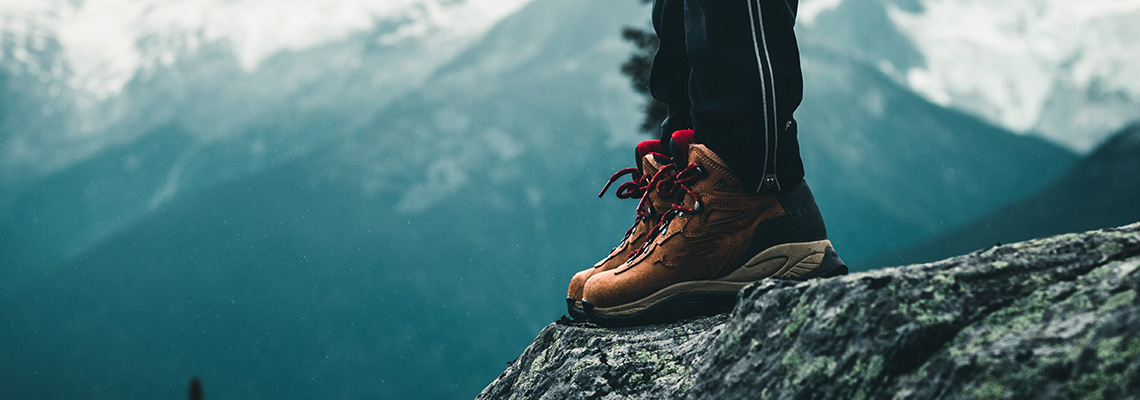What footwear is for you?

What hiking boots or shoes are best for me?
Your chosen footwear needs to be in sync with how and where you hike as it really can make or break your outdoor experience. It is a must for your footwear to fit perfectly. When it comes to footwear we have everything from aqua shoes, to mountaineering boots. When choosing your footwear you will need to consider a few areas:
- Their Fit - no one likes sore feet!
- Design - Knowing what your boots are made of and why can be a vital to their purpose and how they feel when on
- Type - If you are walking 30km of rocky terrain you want a pair designed for that! nothing too soft or without enough ankle support to stop those unwanted sprains!
When Trying on Boots
It’s important when you first go and try on footwear you insure you are wearing the socks you intend to wear them with. If for example you are going hiking then opting for hiking specific socks would provide you with added cushioning, temperature control and moisture-wicking, which all add to the thickness. It is also important to note that feet tend to swell throughout the day – so trying on shoes in the second half of the day when your feet are at their largest is preferable. The ideal fit for a hiking boot is your foot to be snug everywhere enough that there isn’t any movement independent of the shoe. A good rule is to leave no more than a thumbs width between your longest toe and the end of the insole. This will stop any cramping or sore feet on those downhill stretches.
Staff Tip: Break your boots in before you adventure in them! Wear them around the house, short walks around the neighborhood or while you shop!
What type of footwear is there?
- Trail Runners
- Hiking / Approach Shoes
- Hiking / Tramping Boots
- Mountaineering Boots
Trail Runners
Many love the fresh and light weight feel trail runners have. They are designed for running ' off road' and go great on well maintained trails and gravel paths. With their low cut design, high breathability and soft soles, trail runners pack an aggressive impact for maximum traction with the terrain. Many also like trail runners for their bright and fun designs.
Best use: running on gravel, trails and day hiking on relatively smooth trails
Hiking / Approach Shoes
Being lighter than hiking boots and more durable than trail runners, hiking shoes are a popular choice for experienced backpackers and hiking on almost any kind of terrain. You do however need strong feet and ankles, with lots of practice placing your feet, when wearing these shoes. Hiking shoes pack the same punch as boots with the exception of being low-cut.
Best use: day hiking, casual wear and experienced back packers/hikers with minimal loads
Hiking Boots
For hikers who require ankle protection, and want a stable/supportive boot. Hiking boots are generally more durable, whilst providing the most ankle protection on rough, rocky trails. If you’re one to hike on more uneven terrain with slips, roots and large rocks, then it is a good idea to opt for a boot. Hiking boots can be divided into three different types depending on their purpose or average trip duration when used.
Day Hiking Boots
These are hiking shoes with a medium to high cut ankle collar. The high cut ankle collar is more for protection against abrasions rather than stabilization of the ankle in rough terrain and under heavy loads. These boots are still like the traditional hiking/backpacking boot but are often flex easier, require less breaking in but can often be not as durable as your more heavyweight boot. They still offer great ankle support with a softer midsole.
Heavyweight Hiking Boots
These boots are this is the most traditional heavy backpacking or hikers boot. They provide the most stability for the ankle and are the most footwear out of the three categories. This type of boot is suitable for year-round hiking and are generally made out of leather, making them last longer. These boots are designed for bigger trips, longer use and unsteady unpredictable terrain and weather. With stiff midsoles for user support
Mountaineering Boots
If you intent to use technical crampons, you need to opt for a mountaineering boot. These boots are big, burly, and stiff (being insulated for colder weather). They have a full ankle collar, durable construction, and gaiter/crampon compatibility. Mountaineering boots can also be chosen for hiking when you are carrying very heavy loads through rough terrain and weather.


































